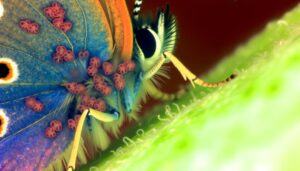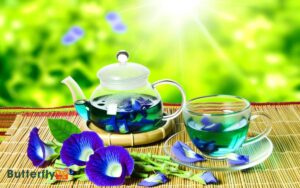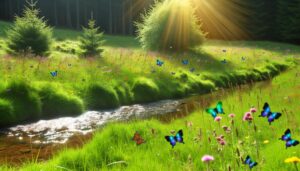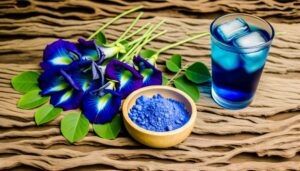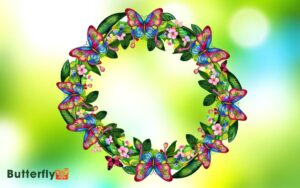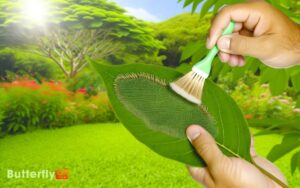How To Make A Butterfly Garden In Florida? A Complete Guide!
To create a butterfly garden in Florida, map it out with nectar-rich plants like Lantana and host plants such as Milkweed in sunny areas. Guarantee six hours of direct sunlight daily.
Select native species for resilience. Plant specific hosts like Passion Vine and Cassia to attract desired butterflies. Use well-drained soil and cluster plants for maximum attraction.
Incorporate nectar sources like Pentas and Coreopsis. Provide water sources with shallow birdbaths or damp sand areas, refreshed regularly.
Arrange taller plants at the back and shorter ones at the front. You’ll discover more nuanced details and tips to optimize your butterfly garden further.
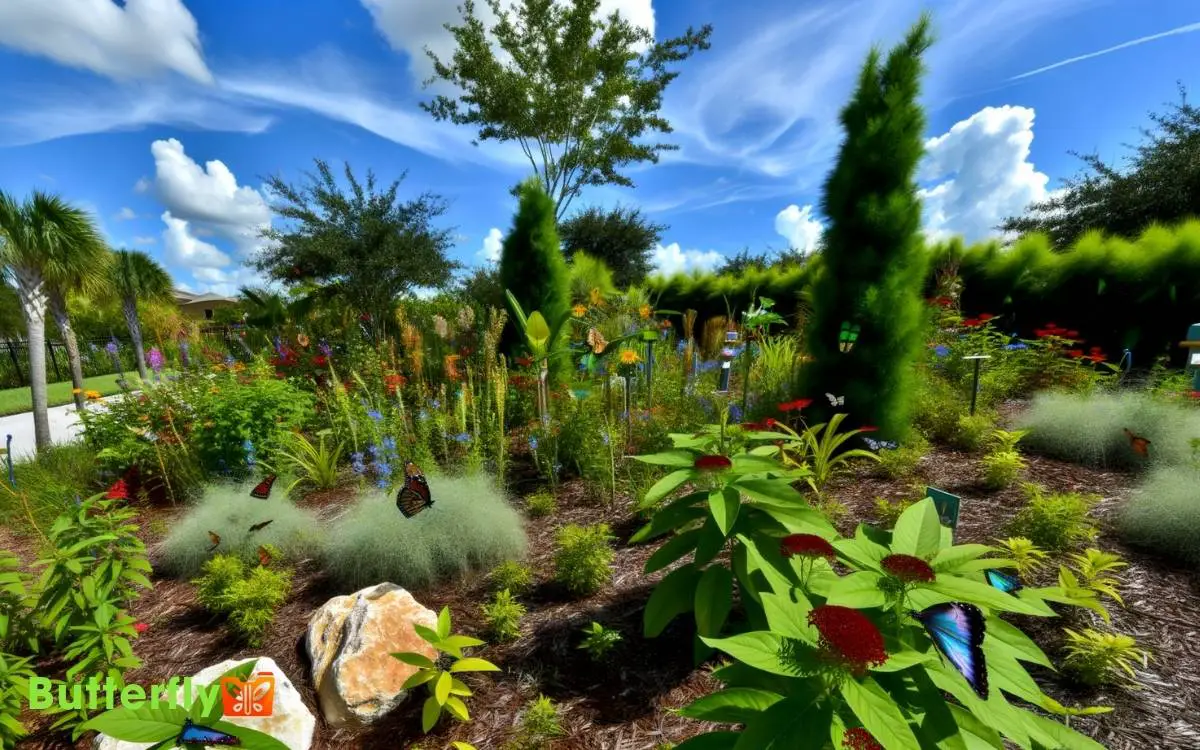
Key Takeaways
Planning Your Garden Layout
Before you begin planting, map out your butterfly garden to make certain it includes a variety of nectar and host plants arranged in sunlit areas. In Florida, sunlight is abundant, so allocate at least six hours of direct sunlight per day for best plant growth.
Use graph paper to sketch your garden layout, marking areas for species like Milkweed (Asclepias spp.) for Monarchs and Passionflower (Passiflora incarnata) for Gulf Fritillaries. Make sure you’ve got a mix of heights and textures to mimic a natural habitat.
Incorporate pathways for easy maintenance and observation. Position taller plants, such as Lantana (Lantana camara), at the back, and shorter ones, like Pentas (Pentas lanceolata), toward the front for layered visual appeal and functional access.
Choosing Butterfly-Friendly Plants
When selecting butterfly-friendly plants, prioritize both nectar plants like Lantana (Lantana camara) for feeding and host plants such as Milkweed (Asclepias spp.) for caterpillar development.
Opt for nectar-rich plants with tubular flowers, like Pentas (Pentas lanceolata) and Firebush (Hamelia patens), which are highly attractive to butterflies.
Additionally, consider native species like the Black-eyed Susan (Rudbeckia hirta) and Blanket Flower (Gaillardia pulchella) for their adaptability and resilience.
For host plants, focus on those that cater to specific butterfly species: Passion Vine (Passiflora incarnata) for Gulf Fritillaries and Cassia (Senna spp.) for Sulphur butterflies.
Maintain a continuous bloom cycle to provide year-round resources. Mixing annuals and perennials will create a dynamic, sustainable habitat.
Planting Host Plants
To successfully plant host plants, start by selecting a sunny location with well-drained soil to guarantee best growth and butterfly attraction. Focus on planting species that cater to the specific butterflies you wish to attract.
- Milkweed (Asclepias spp.): Essential for Monarchs, it provides both nectar and a place for larvae to thrive.
- Passion Vine (Passiflora spp.): Attracts Gulf Fritillaries and Zebra Longwings, offering a critical food source for caterpillars.
- Cassia (Senna spp.): Ideal for Sulphur butterflies, these plants serve dual purposes as shelter and sustenance.
- Parsley (Petroselinum crispum): Favored by Black Swallowtails, it ensures a continual lifecycle by supporting larvae development.
Make sure you plant in clusters to maximize the chances of attracting and sustaining butterfly populations. Grouping nectar-rich flowers together provides a larger and more noticeable feeding area, making it easier for butterflies to locate their food source. Additionally, incorporating a variety of native plants will support different butterfly species throughout their life cycles. If you’re wondering how to start a butterfly farm, begin by researching the best host and nectar plants for your region to create a thriving habitat.
Adding Nectar Sources
For a thriving butterfly garden, include a variety of nectar-rich plants such as Lantana, Pentas, and Coreopsis to guarantee adult butterflies have ample food sources.
Lantana camara, with its vibrant clusters, attracts a wide range of butterfly species. Pentas lanceolata, commonly known as Egyptian Star Cluster, provides continuous blooming, ensuring a steady nectar supply.
Coreopsis, especially Coreopsis lanceolata, offers bright yellow blooms that serve as a magnet for butterflies.
Arrange these plants in clusters to create a more noticeable and accessible nectar source. Make sure full sun exposure as butterflies are more active in sunny areas. Incorporate staggered blooming periods to maintain consistent nectar availability.
Providing Water Sources
To attract butterflies,
- You’ll need to incorporate water features like shallow birdbaths or damp sand areas.
- Create puddling stations using a mix of sand, soil, and water in shallow dishes to provide essential minerals.
- Make sure these water sources are in sunny spots, as butterflies prefer warm, open areas.
Butterfly-Friendly Water Features
Butterflies need shallow water sources, such as birdbaths with flat stones or shallow dishes, to stay hydrated and maintain their delicate ecosystems.
To innovate your butterfly garden in Florida, you should consider the following:
- Use shallow dishes: Opt for dishes no deeper than 1 inch to prevent drowning.
- Incorporate flat stones: These provide safe perches for butterflies to drink without submersion.
- Add aquatic plants: Species like water lilies (Nymphaea spp.) can enhance water quality and attract butterflies.
- Ensure clean water: Regularly refresh the water to prevent algae growth and mosquito breeding.
Creating Puddling Stations
Consider establishing puddling stations by filling shallow containers with a mixture of sand, soil, and water to provide essential minerals and hydration for butterflies in your Florida garden. Opt for containers that are no deeper than one inch to prevent drowning.
Incorporate native plants like Asclepias tuberosa (Butterfly Weed) and Passiflora incarnata (Passionflower) nearby to attract local species such as the Gulf Fritillary and Monarch.
Make sure the soil-sand mix remains moist but not waterlogged by adding water regularly. For additional nutrients, mix in a small amount of compost or organic matter.
Position these stations in sunny areas, as butterflies are more active in warm conditions. This innovative approach fosters a thriving butterfly habitat, promoting biodiversity in your garden.
Ensuring Shelter and Safety
Providing adequate shelter and safety in your butterfly garden involves planting a variety of native shrubs and trees to offer protection from predators and harsh weather conditions.
Utilize specific plant species to create an ideal environment:
- Firebush (Hamelia patens): This native shrub provides dense foliage for shelter and vibrant flowers that attract butterflies.
- American Beautyberry (Callicarpa americana): Its thick branches and berries offer both protection and a food source.
- Southern Red Cedar (Juniperus virginiana): This evergreen tree serves as a year-round refuge from the elements.
- Wax Myrtle (Morella cerifera): Known for its aromatic leaves, it provides a natural deterrent to pests and a safe haven for butterflies.
Maintaining Your Butterfly Garden
After establishing a safe and sheltered environment, it’s crucial to regularly maintain your butterfly garden to guarantee it continues to thrive. Start by monitoring plant health; remove any diseased or infested foliage promptly.
Prune nectar plants like Pentas and Lantana to promote blooming. Fertilize with a balanced, slow-release fertilizer to enhance plant vigor.
Ensure consistent moisture levels by mulching with organic materials, which also helps control weeds. Inspect milkweed for aphids and manually remove them or use insecticidal soap.
Rotate plant species seasonally to provide continuous nectar sources. Lastly, avoid using synthetic pesticides, as they can harm butterflies and larvae. This proactive approach ensures a sustainable, vibrant habitat for your butterfly garden.
Conclusion
Creating a butterfly garden in Florida combines scientific precision with natural beauty. By juxtaposing meticulous planning with vibrant plant selection, you’ll attract a plethora of butterfly species.
Host plants like milkweed and nectar sources such as lantana guarantee both sustenance and allure. Water sources and shelter, juxtaposed with Florida’s unique climate, provide a haven for butterflies.
Maintain your garden meticulously, and you’ll witness a thriving, dynamic ecosystem right in your backyard.

